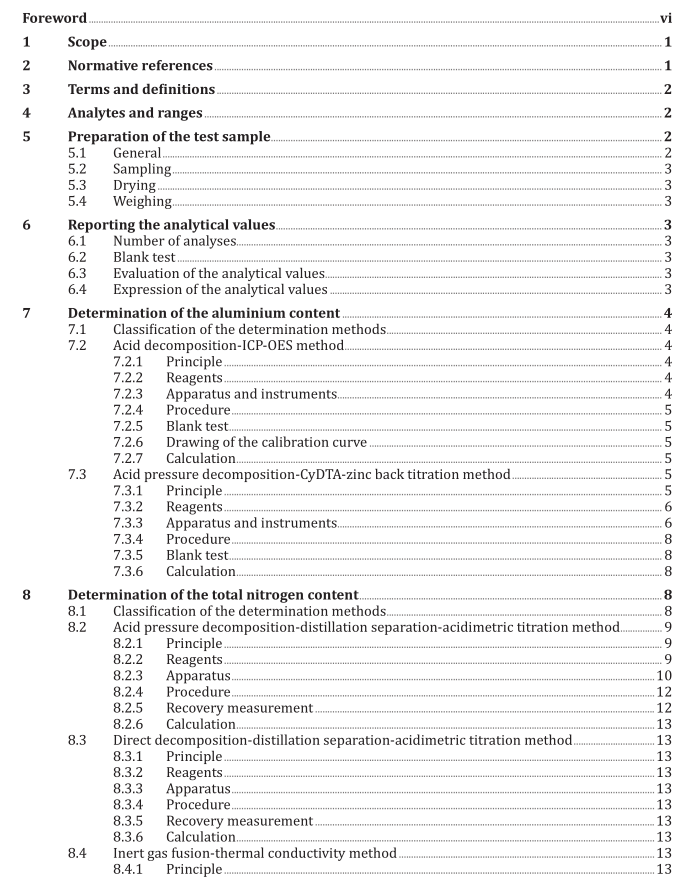ISO 21814 pdf download

ISO 21814 pdf download Fine ceramics (advanced ceramics, advanced technical ceramics) — Methods for chemical analysis of aluminium nitride powders
1 Scope
This document specifies methods for the chemical analysis of fine aluminium nitride powders used as the raw material for fine ceramics. This document stipulates the determination methods of the aluminium, total nitrogen, boron, calcium, copper, iron, magnesium, manganese, molybdenum, nickel, potassium, silicon, sodium, titanium, tungsten, vanadium, zinc, zirconium, carbon, chlorine, fluorine, and oxygen contents in aluminium nitride powders.
The aluminium content is determined by using either an acid pressure decomposition- CyDTA-zinc back titration method or an acid digestion-inductively coupled plasma-optical emission spectrometry (ICP-OES) method. The total nitrogen content is determined by using an acid pressure decomposition-distillation separation-acidimetric titration method, a direct decomposition-distillation separation-acidimetric titration method, or an inert gas fusion-thermal conductivity method. The boron, calcium, copper, iron, magnesium, manganese, molybdenum, nickel, potassium, silicon, sodium, titanium, tungsten, vanadium and zinc contents are determined by using an acid digestion- ICP-OES method or an acid pressure decomposition-ICP-OES method. The sodium and potassium contents are determined via an acid pressure decomposition-flame emission method or an acid pressure decomposition-atomic absorption spectrometry method. The oxygen content is determined by using an inert gas fusion-IR absorption spectrometry method, while that of carbon is determined via a combustion-IR absorption spectrometry method or a combustion-conductometry method. The chlorine and fluorine contents are determined by using a pyrohydrolysation method followed by ion chromatography or spectrophotometry.
2 Normative references
The following documents are referred to in the text in such a way that some or all of their content constitutes requirements of this document. For dated references, only the edition cited applies. For undated references, the latest edition of the referenced document (including any amendments) applies.
ISO 2828,Aluminium oxide primarily used for the production of aluminium —Determination of fluorinecontent —Alizarin complexone and lanthanum chloride spectrophotometric method
ISO 3696,Water for analytical laboratory use — Specification and test methods
ISO 8656-1,Refractory products — Sampling of raw materials and unshaped products — Part 1:Sampling scheme
ISO 21068-3:2008,Chemical analysis of silicon-carbide-containing raw materials and refractoryproducts —Part 3: Determination of nitrogen, oxygen and metallic and oxidic constituents
ISO 21438-2,Workplace atmospheres — Determination of inorganic acids by ion chromatography 一Part 2: Volatile acids, except hydrofluoric acid (hydrochloric acid, hydrobromic acid and nitric acid)
ISO 21438-3,Workplace atmospheres — Determination of inorganic acids by ion chromatography 一Part 3: Hydrofluoric acid and particulate fluorides
ISO 26845:2008,Chemical analysis of refractories —General requirements for wet chemical analysis,atomic absorption spectrometry (AAS) and inductively coupled plasma atomic emission spectrometry (1icP-AES) methods
3? Terms? and? definitions
No terms and definitions are listed in this document.
ISO and IEC maintain terminological databases for use in standardization at the following addresses:
— ISO Online browsing platform: available at https: //www .iso .org/obp
— IEC Electropedia: available at http: //www .electropedia .org/
4 Analytes and ranges
a) Aluminium (Al), range of 40 % to 70 % (mass fraction).
b) Total nitrogen (T.N), range of 20 % to 40 % (mass fraction).
c) Boron (B), range of 0,001 % to 0,03 % (mass fraction).
d) Calcium (Ca), range of 0,001 % to 0,03 % (mass fraction).
e) Copper (Cu), range of 0,001 % to 0,03 % (mass fraction).
f) Iron (Fe), range of 0,001 % to 0,03 % (mass fraction).
g) Magnesium (Mg), range of 0,001 % to 0,03 % (mass fraction).
h) Manganese (Mn), range of 0,001 % to 0,03 % (mass fraction).
i) Molybdenum (Mo), range of 0,001 % to 0,03 % (mass fraction).
j) Nickel (Ni), range of 0,001 % to 0,03 % (mass fraction).
k) Potassium (K), range of 0,001 % to 0,03 % (mass fraction).
l) Silicon (Si), range of 0,001 % to 0,03 % (mass fraction).
m) Sodium (Na), range of 0,001 % to 0,03 % (mass fraction).
n) Titanium (Ti), range of 0,001% to 0,03 % (mass fraction).
o) Tungsten (W), range of 0,001 % to 0,03 % (mass fraction).
p) Vanadium (V), range of 0,001 % to 0,03 % (mass fraction).
q) Zinc (Zn), range of 0,001 % to 0,03 % (mass fraction).
r) Carbon (C), range of 0,01 % to 6 % (mass fraction).
s) Chlorine (Cl), range of 0,001 % to 0,5 % (mass fraction).
t) Fluorine (F), range of 0,001 % to 0,2 % (mass fraction).
u) Oxygen (O), range of 0,05 % to 5 % (mass fraction).
5 Preparation of the test sample
5.1 General
The sample preparation method shall be in accordance with ISO 8656-1, unless otherwise mutually agreed upon by the analyser and customer.









